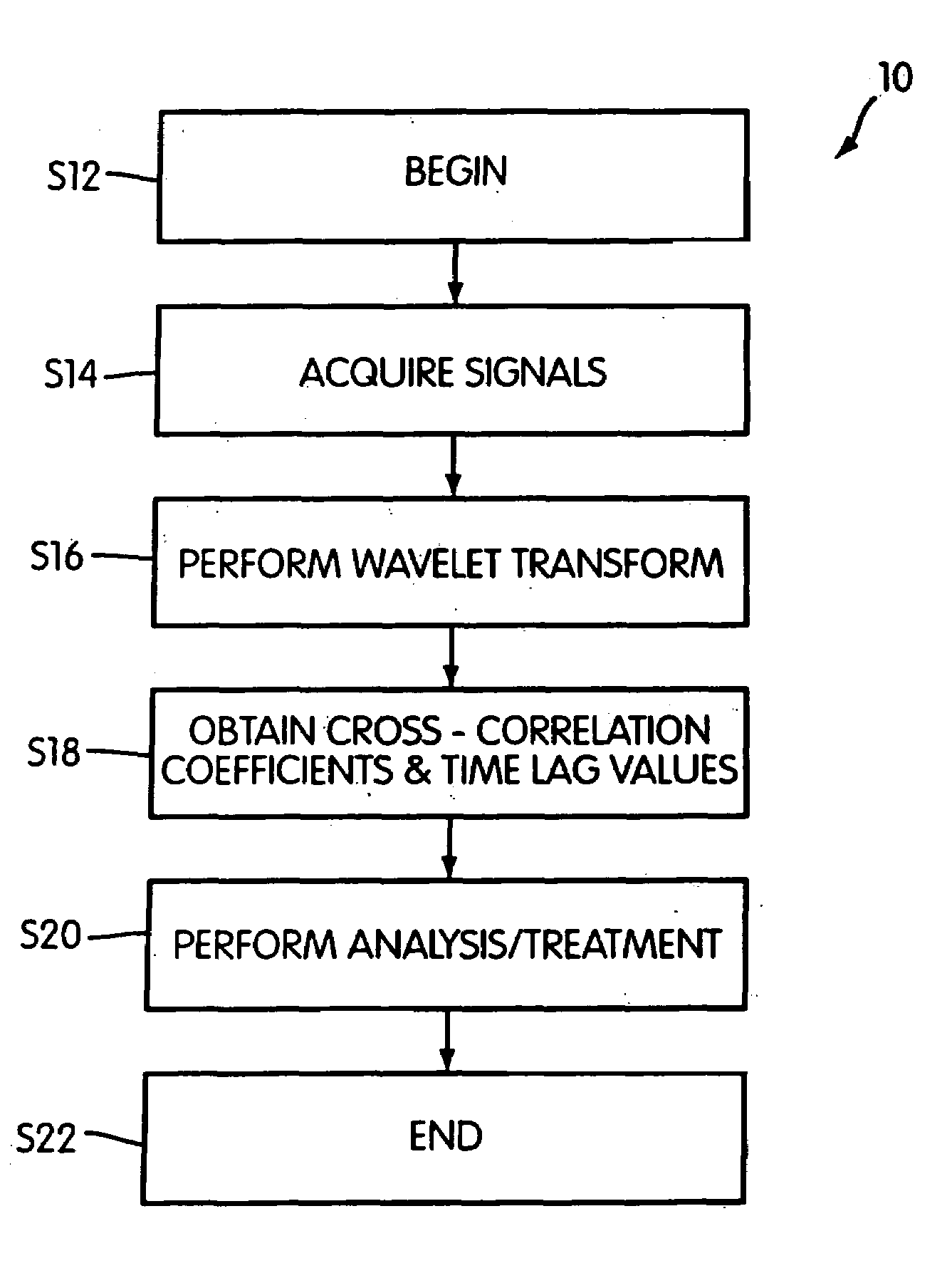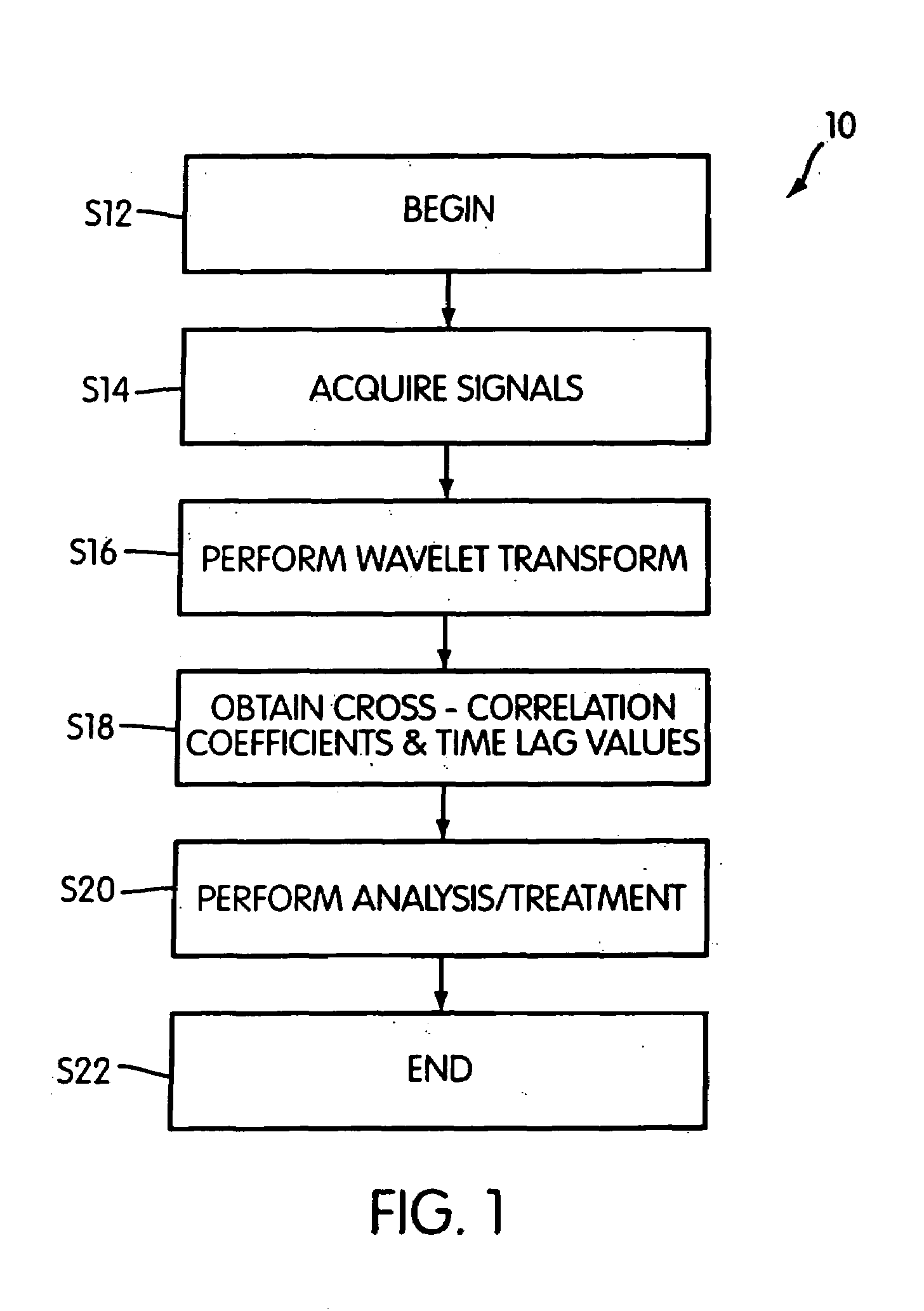Signal analysis, heat flow management, and stimulation techniques to treat medical disorders
a technology of signal analysis and heat flow management, applied in the direction of contraceptive devices, artificial respiration, therapy, etc., can solve the problems of two difficulties often encountered
- Summary
- Abstract
- Description
- Claims
- Application Information
AI Technical Summary
Benefits of technology
Problems solved by technology
Method used
Image
Examples
example 1
Wavelet Cross-Correlation
[0046]Electrical stimulation of the brain is performed for a variety of clinical reasons, for example, to help localize areas of brain controlling movement, sensation, language, and other functions (sometimes referred to as “localizing stimulation” or LS). However, LS may produce activity of epileptiform morphology called afterdischarges. These afterdischarges can be understood as a model for epilepsy.
[0047]Afterdischarges and the effect of brief pulse stimulation (BPS) on afterdischarges were studied. No single, typical form of ADs was noted. Effect of BPS was not dependent upon pretreatment with anticonvulsant medication, relative time of ADs, or treatment latency. In addition, BPS was effective in all lobes stimulated, for all types of ADs, and both in regions that did and did not produce interictal epileptiform discharges; however, degree of effectiveness depended on these variables. For example, BPS was most effective anteriorly and least effective post...
example 2
Wavelet Cross-Correlation
[0049]The value of wavelet cross-correlation analysis was assessed in 57 events in which afterdischarges (ADs) appeared in response to stimulation of brain cortical tissue in humans. Mean durations of epoch 1, 2 and 3 were 9.9, 11.3 and 14.5 seconds, respectively. For controls in analysis-2 we chose 59 events in which ADs did not appear after cortical stimulation. Significant differences of WCC values tended to occur between epochs 1 and 2, and 2 and 3. On the other hand, there were few significant differences in WCC between epochs 1 and 3.
[0050]The results suggested that activity propagated from one electrode to another with a time lag. Short time lags (less than 10 milliseconds) occurred less frequently during epoch 2, but that time lags of 10 milliseconds occurred more frequently during epoch 2.
[0051]In summary, results indicated that there were significant differences in WCC and TL when comparing among different epochs. These differences can be utilized ...
example 3
Discrete Wavelet Cross-Correlation / Neighbor Correlation Count
[0052]EEG Data were recorded from patients using Telefactor Beehives (Astro-Med, Grass-Telefactor, West Warwick, R.I., USA) sampling at 200 samples per second. The low pass filter was set at 70 Hz, while the high pass filter was set at 1 Hz. These systems use 12 bit analog to digital converters. The Beehives save recorded EEG data to a file server in data files. Those data files were analyzed off-line once data collection was complete.
[0053]In the analysis, which included the tasks of method 100, the discrete approximation to the continuous wavelet transform was used. The real part of the Gabor function, which is a cosine wave with an exponential taper, was chosen as the basic wavelet. The complex Gabor function was not used in order to simplify the calculations and increase processing speed. The use of only the real portion of the Gabor function did not result in any significant loss of information. The equation for the d...
PUM
 Login to View More
Login to View More Abstract
Description
Claims
Application Information
 Login to View More
Login to View More - R&D
- Intellectual Property
- Life Sciences
- Materials
- Tech Scout
- Unparalleled Data Quality
- Higher Quality Content
- 60% Fewer Hallucinations
Browse by: Latest US Patents, China's latest patents, Technical Efficacy Thesaurus, Application Domain, Technology Topic, Popular Technical Reports.
© 2025 PatSnap. All rights reserved.Legal|Privacy policy|Modern Slavery Act Transparency Statement|Sitemap|About US| Contact US: help@patsnap.com



